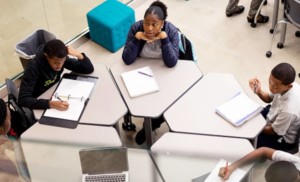Focusing on Feedback: A Conversation with Amy Tepper and Patrick Flynn About Supporting Educators During Distanced Teaching

By: Adam Geller
Collecting evidence of teaching practice and providing feedback based on that evidence is critical to the professional learning process. For teachers to be successful—especially this year with distanced teaching—this is a practice that needs to be prioritized.
Amy Tepper and Patrick Flynn, educational coaches and co-authors of multiple books including Feedback to Feed Forward: 31 Strategies to Lead Learning, are experts on driving organizational change by helping teachers, instructional coaches, school leaders, and administrators through the feedback process. I recently had multiple conversations with them about how feedback impacts the teaching and learning process.
After first discussing the importance of understanding students’ emotional well-being in order to effectively lead student learning, they shared valuable tips and strategies on how coaches can use feedback to help teachers continuously improve their practice, especially now with many teaching remotely.
Now that we don’t have a traditional way of thinking about what teaching looks like, how can coaches still collect the evidence needed for feedback?
Flynn: There are eight strategies based on real experience inside classrooms that we cover in our books with three that we call the trifecta—look, listen, and interact. The whole idea is that everything we’re trying to collect should really be about the learning, specifically what and how learning is occurring. This includes understanding the learning in the context of the environment and the purpose of the lesson itself.
The idea of ‘look, listen, and interact’ really gives a platform to develop some of those core strategies, as well as those core look-fors as to what evidence to collect.
Building upon that, what does this look like for distanced teaching during the pandemic?
Tepper: Basically as coaches, you’re doing and looking for the same things—you’re looking at the learning taking place and how teachers are impacting the learning.
But what we need to think about now is what tools are available to help facilitate this process. For those who were already using video-based observation, this won’t feel like a big jump. For example, coaches can go and watch a teacher’s screencast of a quick mini-lesson or join Zoom conversations, and both of these would feel like comfortable steps.
The interaction part of the trifecta—after listening to a Zoom call and reading or looking at student work—can be more challenging however it can still be really rich. We should continue to think about how to use surveys or how to jump into a small group in Zoom as a leader, peer, or coach and engage with those learners while the teacher is in another group.
Interaction is still possible—teachers in synchronous settings are engaging with learners, and so can we as coaches.
Why is providing feedback so important in a time like this?
Flynn: It’s really important to consider the impact of feedback and how it is the driving force in a culture of learning. It is the mechanism that leaders, coaches, and educators can utilize collaboratively in many ways to build and cultivate a different mindset about the learning that needs to be occurring.
Feedback becomes the platform upon which professional learning can be designed specifically to address strengths that exist within a building, as well as the needs that exist within a building. So, when we think about our virtual environments now and we see the patterns of feedback that are coming out of any sort of information gathering or collaboration, we’re able to utilize that feedback and make it have an impact on the learning that’s happening.
Tepper: Feedback is equally as powerful when teachers are out of buildings, even though it might look a little different.
When many states dropped their teacher evaluation requirements (requirements which teachers may have had negative connotations and experiences about), it opened up this world where coaches can just get in and check out teaching and give good feedback. The whole process is all about growth and supporting teachers. So, we’re hopeful that from all of this, teachers will suddenly see feedback as a positive and that it can be a really positive experience for their professional growth.
For more, see:
- Supporting District Change Through Learner-Centered Leadership
- Always Ready For Learning: Meeting the Rapidly Evolving Needs of Educators Throughout COVID-19
- How Continuous Feedback Fosters Learning
Adam Geller is the author of “Evidence of Practice: Playbook for Video-Powered Professional Learning” and founder of Edthena, a teacher video observation and online collaboration platform for educators.
Amy Tepper and Patrick Flynn of Tepper and Flynn are educational coaches and co-authors of multiple books including Feedback to Feed Forward: 31 Strategies to Lead Learning. Follow them on Twitter at @ATep46 and @PatFlynn.
To watch more of this interview with Tepper and Flynn, visit the Edthena blog at https://blog.edthena.com/tepperandflynn.
Stay in-the-know with innovations in learning by signing up for the weekly Smart Update.


0 Comments
Leave a Comment
Your email address will not be published. All fields are required.